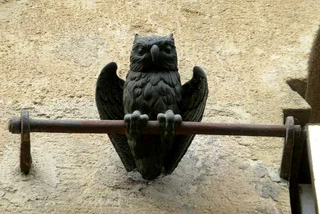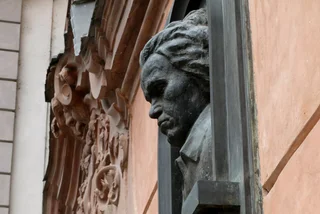It’s hard to walk around Prague without seeing images of composer Wolfgang Amadeus Mozart. He’s most closely associated with conducting the premiere of “Don Giovanni” on Oct. 29, 1787, but that wasn’t his first time in the Golden City, or even on the conductor’s podium at what is now the Estates Theatre.
On Jan. 20, 1787, he held the baton for a performance of “The Marriage of Figaro.” This event is less well-known because that opera was already almost a year old, having premiered in Vienna in May. This Prague staging had already been in the theater's repertoire for possibly over a month.
The Prague staging was already a success before Mozart came. A German-language newspaper in Prague called Oberpostamtzeitung stated: "No piece (so everyone here asserts) has ever caused such a sensation as the Italian opera 'The Marriage of Figaro,' which has already been given several times here with unlimited applause."
The opera remains one of Mozart's best-loved works. In 2017 it was voted the best opera of all time by 172 opera singers polled by BBC News Magazine. “Don Giovanni” came in eighth on the same ranking.
The opera's success led a group of Mozart's fans to raise money for the Maestro to come in person. While in Prague, Mozart attended several receptions and for a few weeks was the toast of the town.
He attended a performance of “The Marriage of Figaro.” on Jan. 17, and two days later he conducted the premiere of “The Prague Symphony” at a benefit concert, where he was able to keep most of the admission fees. He then conducted “Figaro” the day after that.

The symphony was likely finished on Dec. 11, 1786. Some scholars speculate it was composed with Prague in mind, as the city was known for its skilled wind instrument players and the piece has some notable wind passages. Another theory, though, is that he wrote it for an Advent concert in Vienna, and held it back so he would have something new for his Prague debut, without having to rush together another piece.
The Maestro arrived in Prague on Jan. 11, 1787, and stayed until mid-February at a palace owned by the noble Thun family. They owned several in Prague, and which palace he stayed at has recently become a matter of dispute. It was long thought be what is now the British Embassy, in Malá Strana on Thunovská Street. A letter thanking his hosts is still in the possession of the embassy, according to one of the former ambassadors.
A book published in 2021, "Mozart in Prague" by Daniel E. Freeman, claims Mozart stayed at the Thun's palace at Sněmovní 4, which burned down in the 1790s and was rebuilt.

During this first trip, Mozart went to pubs on Štupartská Street such as the long-gone U Štupartsků and had coffee for the first time somewhere on Templová Street. Reportedly, he liked the beverage. He also frequented the New Inn at Celetná 588, later called U Zlatého anděla, located near the Powder Gate.
He visited the Klementinum several times during this trip and heard students play one of his works there. A marble bust of him, with imperial laurels on his head, is in the entry of the Klementinum's Mirror Chapel.

Prague was late to the Mozart party, compared to Moravia. Smallpox or chickenpox broke out in Vienna in 1786, when Mozart was 11. The Mozart family went to Olomouc, first staying at the inn U Černého orla (At the Black Eagle), now known as Hauenschild Palace. Wolfgang, though, soon fell ill and was moved to the cathedral deanery. During his recovery, he composed Symphony No. 6 in F major. He was in Olomouc from October to late December 1767.
The family also stopped briefly in Brno, and Wolfgang performed in the Taverna, now called the Reduta theater, on Dec. 30, 1786. After this, the family returned to Vienna.
Mozart’s second trip to Prague is his most famous. This was when he conducted the premiere of his opera “Don Giovanni” at the Estates Theatre on Oct. 29, 1787. A ghostly statue, “Il Commendatore” by Anna Chromý, and a bronze plaque commemorate the event. During this trip, he allegedly said: “My Praguers understand me,” or words to that effect. The quote, though, only comes from second-hand sources.

He stayed from October to November 1787, first living at Uhelný trh 420, then called U Tří lvíčků. A plaque is now on the building. He apparently shot billiards and went drinking on Skořepka Street at a pub called U Šturmů and frequented a pub called U Modrého hroznu, across the street from the Estates Theatre. Both are long gone. Mozart’s librettist, Lorenzo Da Ponte, stayed at Platýz, also on Uhelný trh.
He was possibly invited by the Dušek family to move to Betramka, out in what is now Prague 5, and might have written the aria “Bella mia fiamma addio” there, after being locked in a room until he finished it. He had long promised to write it for Josephine Dušek, a famous singer of the time. The place is now a Mozart museum. As with many tales related to Mozart, this one didn’t emerge until long after the Maestro had died, and there is little solid evidence to confirm it.

He visited Strahov Monastery on Nov. 16, 1787, and improvised on the organ at Church of the Ascension of the Virgin Mary, and also played the organ at the Church of Sts. Simon and Jude, now used as a concert hall, and played the harpsichord at the hospital Na Františku.
On this trip, he wrote six German dances for Jan Josef Pachta, a supporter of the arts. A building owned by the Pachta family, Pachtův Palác, is now part of The Mozart Prague hotel complex. He allegedly lived in the palace as well, but again there is little to support the claim. For him to have lived in all the places he is supposed to have on this trip, he would have been moving quite a lot.
His third visit to Prague was in April 1789, but just for one night on his way to Berlin. He stopped at U Zlatého jednorožce in Malá Strana, near Maltézské náměstí. A plaque on the building mentions Beethoven staying there, but not Mozart as it was so brief. He apparently met his friend, František Xaver Dušek, the owner of Bertramka. Mozart’s fourth visit was on his way back from Berlin.
His fifth and last visit was in August 1791, to conduct a gala opera to mark the coronation of Leopold II. Apparently, much of “La clemenza di Tito,” which premiered Sept. 2, 1791, at the Estates Theater, was composed in the coach ride.
Most died Dec. 5, 1791, in Vienna. A memorial mass was celebrated at St. Mikuáš Church in Prague’s Malá Strana on Dec. 14, with Josefina Dušek singing an aria from Rössler’s Requiem. Bells rang across the city.
Mozart is also associated with Prague due to Miloš Forman’s 1984 film “Amadeus.” Locations include the Estates Theatre, streets and palaces near Prague Castle, Invalidovna, the Church of St Giles (Kostel sv. Jiljí), several streets and palaces near Maltézské náměstí, the Wallenstein Gardens, Vyšehrad, and the cemetery in Bohnice.












 Reading time: 5 minutes
Reading time: 5 minutes 






























